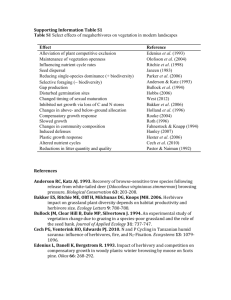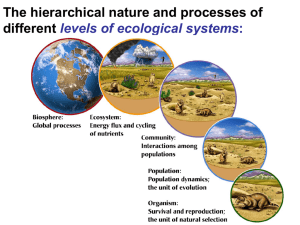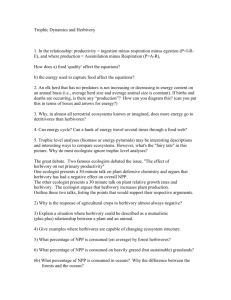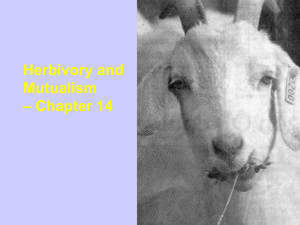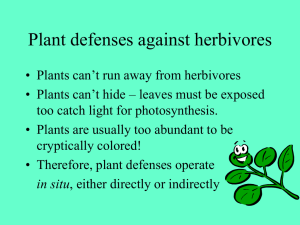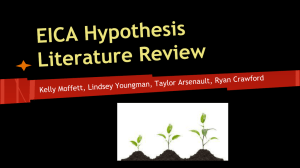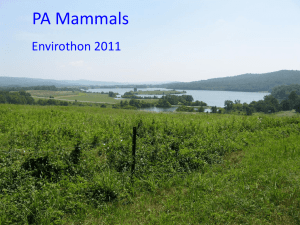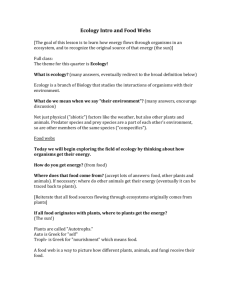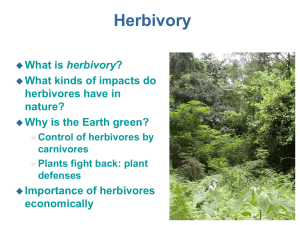02 Herbivory Rubric
advertisement
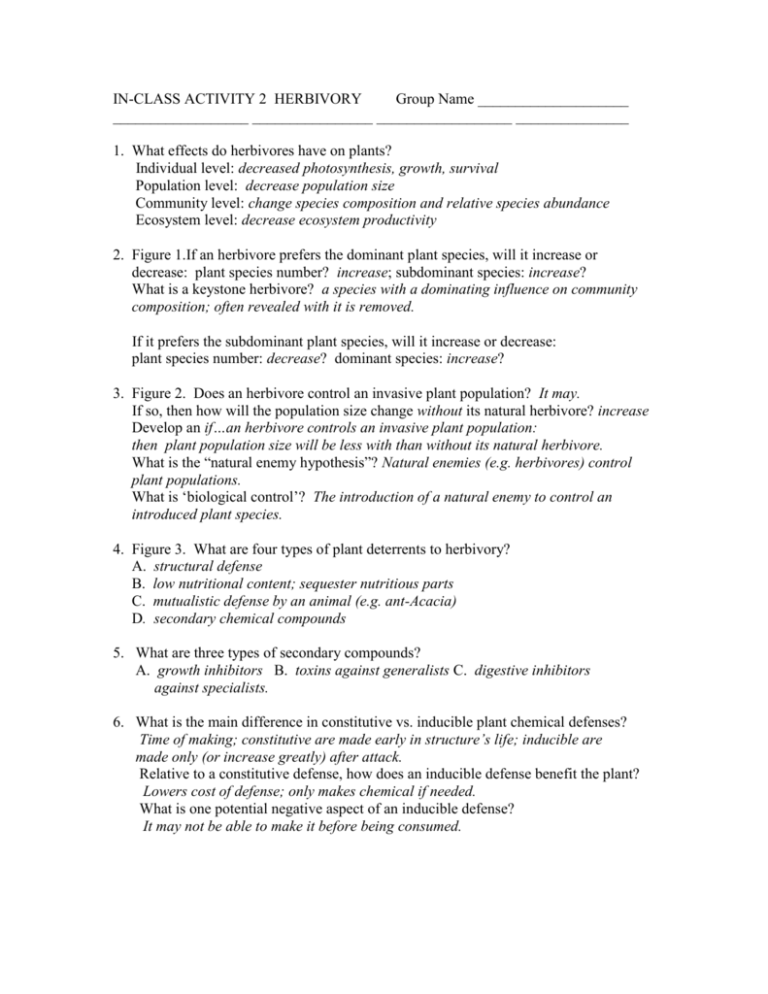
IN-CLASS ACTIVITY 2 HERBIVORY Group Name ____________________ __________________ ________________ __________________ _______________ 1. What effects do herbivores have on plants? Individual level: decreased photosynthesis, growth, survival Population level: decrease population size Community level: change species composition and relative species abundance Ecosystem level: decrease ecosystem productivity 2. Figure 1.If an herbivore prefers the dominant plant species, will it increase or decrease: plant species number? increase; subdominant species: increase? What is a keystone herbivore? a species with a dominating influence on community composition; often revealed with it is removed. If it prefers the subdominant plant species, will it increase or decrease: plant species number: decrease? dominant species: increase? 3. Figure 2. Does an herbivore control an invasive plant population? It may. If so, then how will the population size change without its natural herbivore? increase Develop an if…an herbivore controls an invasive plant population: then plant population size will be less with than without its natural herbivore. What is the “natural enemy hypothesis”? Natural enemies (e.g. herbivores) control plant populations. What is ‘biological control’? The introduction of a natural enemy to control an introduced plant species. 4. Figure 3. What are four types of plant deterrents to herbivory? A. structural defense B. low nutritional content; sequester nutritious parts C. mutualistic defense by an animal (e.g. ant-Acacia) D. secondary chemical compounds 5. What are three types of secondary compounds? A. growth inhibitors B. toxins against generalists C. digestive inhibitors against specialists. 6. What is the main difference in constitutive vs. inducible plant chemical defenses? Time of making; constitutive are made early in structure’s life; inducible are made only (or increase greatly) after attack. Relative to a constitutive defense, how does an inducible defense benefit the plant? Lowers cost of defense; only makes chemical if needed. What is one potential negative aspect of an inducible defense? It may not be able to make it before being consumed. 7. Figure 4. Are herbivores generalists or specialists (selective feeders)? Depends on species. If they are specialists, then in what proportion will they eat an array of species? according to the species’ availability or in a different proportion? Is the hypothesis supported by these data? Yes; proportion eaten does not equal proportion available. What are three factors that may explain the results (selectivity)? differences in: A. chemical defense B. nutrition (quantity; specific nutrient) C. leaf toughness 8. Figure 5. Generate a WHY question relating to this figure. What factors cause the number of caterpillar species feeding to decline from spring to fall? Develop an “If…then” to answer your question. If oak leaves become less suitable insect food as they age, then caterpillars fed young leaves will grow better than if fed older leaves. Figure 6. Do the data support the hypothesis? Yes. What are three underlying factors (hypotheses) that could account for these results? older leaves A. are tougher B. have more chemical defenses C. have less nutrient quality 9. Figure 7. Describe the results. As leaves age (get longer) they become tougher. 10. Figure 8. What is a prediction for the leaf toughness hypothesis? then larvae should grow equally well on ground-up old and new leaves. What is a prediction for the chemical defense hypothesis? then larvae should grow better on ground-up leaves of young than old leaves. Figure 9. Which hypothesis do the data support? Leaf toughness Which of the three hypotheses about underlying factors) that remains untested? Poorer nutrition in older leaves 11. Herbivores consume about 10% of plant productivity. Why is the value so low? or Why is the world still green? Herbivore population size is held in check. What are five factors that control herbivory populations? A. predators B. other herbivores C. plant traits D. soil nutrients E. weather 12. Figure 10. What do the “top-down” vs. “bottom-up” hypotheses attempt to explain? Do higher or lower trophic levels influence sizes of trophic levels? What is the difference between the two? Top-down starts with control by predators; bottom=up starts with control by abiotic factors that affect plants. What is meant by “tri-trophic interactions? Give an example. Interactions involving 3 trophic levels, often with level 3 having indirect affects via level 2 on level 1. E.g. birds controlling insect herbivores indirectly affect leaf loss to herbivores. 13. Figure 11.Despite many potential herbivores, why do leaves lose a low leaf area? If bird predation on insect herbivores reduces the amount of leaf area consumed, then more leaf area consumed will be consumed by plants with birds excluded than by plants exposed to birds. Figure 12. Do the data support the hypothesis? Yes. If forest fragmentation decreases bird populations, what may happen to herbivory? It may increase without top-down control by birds. If climate change causes earlier phenology for plants and caterpillars, but not birds that time their migration N by photoperiod, what may happen to herbivory? It may increase because birds are not present (yet) when caterpillars eat the young developing leaves.
